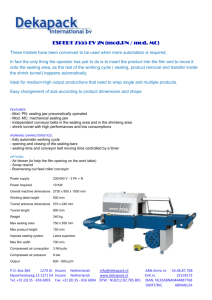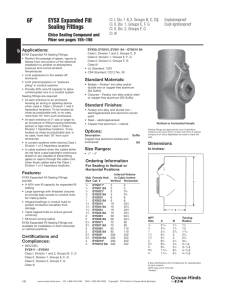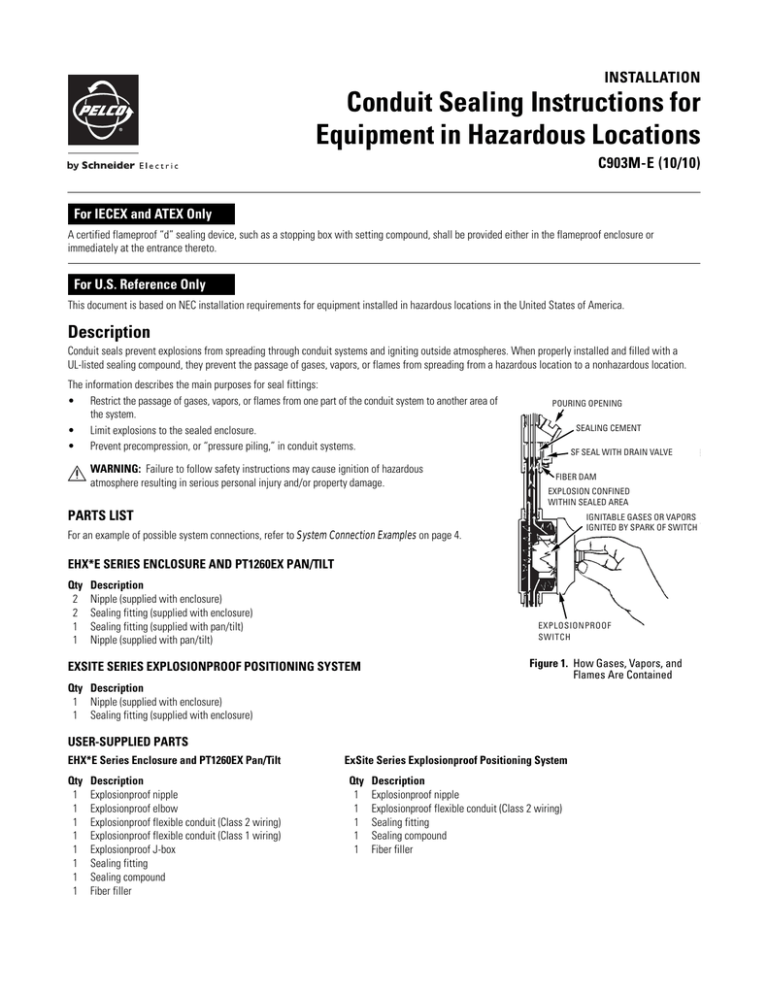
INSTALLATION
Conduit Sealing Instructions for
Equipment in Hazardous Locations
C903M-E (10/10)
For IECEX and ATEX Only
A certified flameproof “d” sealing device, such as a stopping box with setting compound, shall be provided either in the flameproof enclosure or
immediately at the entrance thereto.
For U.S. Reference Only
This document is based on NEC installation requirements for equipment installed in hazardous locations in the United States of America.
Description
Conduit seals prevent explosions from spreading through conduit systems and igniting outside atmospheres. When properly installed and filled with a
UL-listed sealing compound, they prevent the passage of gases, vapors, or flames from spreading from a hazardous location to a nonhazardous location.
The information describes the main purposes for seal fittings:
• Restrict the passage of gases, vapors, or flames from one part of the conduit system to another area of
the system.
• Limit explosions to the sealed enclosure.
• Prevent precompression, or “pressure piling,” in conduit systems.
WARNING: Failure to follow safety instructions may cause ignition of hazardous
atmosphere resulting in serious personal injury and/or property damage.
POURING OPENING
SEALING CEMENT
SF SEAL WITH DRAIN VALVE
FIBER DAM
EXPLOSION CONFINED
WITHIN SEALED AREA
PARTS LIST
IGNITABLE GASES OR VAPORS
IGNITED BY SPARK OF SWITCH
For an example of possible system connections, refer to System Connection Examples on page 4.
EHX*E SERIES ENCLOSURE AND PT1260EX PAN/TILT
Qty
2
2
1
1
Description
Nipple (supplied with enclosure)
Sealing fitting (supplied with enclosure)
Sealing fitting (supplied with pan/tilt)
Nipple (supplied with pan/tilt)
EXPLOSIONPROOF
SWITCH
EXSITE SERIES EXPLOSIONPROOF POSITIONING SYSTEM
Figure 1. How Gases, Vapors, and
Flames Are Contained
Qty Description
1 Nipple (supplied with enclosure)
1 Sealing fitting (supplied with enclosure)
USER-SUPPLIED PARTS
EHX*E Series Enclosure and PT1260EX Pan/Tilt
Qty
1
1
1
1
1
1
1
1
Description
Explosionproof nipple
Explosionproof elbow
Explosionproof flexible conduit (Class 2 wiring)
Explosionproof flexible conduit (Class 1 wiring)
Explosionproof J-box
Sealing fitting
Sealing compound
Fiber filler
ExSite Series Explosionproof Positioning System
Qty
1
1
1
1
1
Description
Explosionproof nipple
Explosionproof flexible conduit (Class 2 wiring)
Sealing fitting
Sealing compound
Fiber filler
NEC SEC. 501-5 HIGHLIGHTS ON SEALING FITTING REQUIREMENTS
CLASS I, DIV. 1 AND 2
Seals must be placed in each conduit of a device that might produce arcs, sparks, or high temperatures.
SEC. 501-5(A)(1)
PERMITS
EXPLOSIONPROOF
UNIONS AND
ELBOWS BETWEEN
SEAL AND
APPARATUS
ENCLOSURE.
18 MAX
ENCLOSURE
TO BE SEALED
Figure 2. Seals Within Conduit Smaller Than 2 Inches
If the conduit is 2 inches or larger, a seal must be placed within 18 inches of the enclosure.
18 MAX
2 OR LARGER
CONDUIT
ENCLOSURE
TO BE SEALED
Figure 3. Seals Within Conduit Larger Than 2 Inches
Sealing fittings must be installed at a boundary between a hazardous and nonhazardous area. Sealing fittings must also be installed at a boundary between
a Class I, Div. 1 area and a Class I, Div. 2 area.
HAZARDOUS AREA
NONHAZARDOUS AREA
ENCLOSURE
TO BE SEALED
NONHAZARDOUS AREA
SEAL MAY BE POSITIONED
ON EITHER SIDE OF BOUNDARY
HAZARDOUS AREA
NO UNION, COUPLING, BOX, OR FITTING IN CONDUIT
IS PERMITTED BETWEEN SEALING FITTING AND
POINT WHERE CONDUIT LEAVES HAZARDOUS AREA
ENCLOSURE TO BE SEALED
Figure 4. Sealing the Enclosures
Other NEC Requirements:
• Splices and taps are not to be used in sealing fittings.
• Where moisture may accumulate in system, an approved method must be provided to remove such accumulation.
• Depth of sealing compound should be to trade size of conduit, having a minimum thickness of 5/8 of an inch.
Installation
1. Run the conductors through the fitting.
2. Pack the sealing fitting with fiber filler. In a horizontal run, place the fiber filling at both ends of the fitting (refer to Figure 5); in a vertical run, fill only
the bottom end (refer to Figure 6).
Fiber filler makes a dam that keeps the sealing compound in the chamber of the sealing fitting while it cures and hardens. The fiber dam is also used
to separate the individual conductors so the sealing compound seals around each conductor. If the electrical conductors are not properly separated,
gases can migrate through the seal, making the seal ineffective.
SEALING COMPOUND
SEALING
COMPOUND
FIBER FILLER
FIBER FILLER
Figure 5. Horizontal Fitting, Damming and Sealing
Figure 6. Vertical Fitting, Damming and Sealing
3. Prepare the sealing compound. Use sealing compound suitable for the application and follow the instructions supplied by the sealing compound
manufacturer.
4. Pour the sealing compound into the fitting.
System Connection Examples
NOTE: The following illustrations of system connections are provided only as a guideline. Actual connections are dictated by local authorities and the A&E
specifications of the site. Pelco makes no recommendations on the connection of this system in a hazardous location.
ì
Nipples (supplied with enclosure)
î
Sealing fittings (supplied with enclosure)
ï
Explosionproof nipple
ñ
Explosionproof elbow
ó
Explosionproof flexible conduit, for Class 2 wiring
r
Explosionproof flexible conduit, for Class 1 wiring
s
Explosionproof J-box, for connection of pan/tilt and
Class-1 camera; for ease of wire pulls, locate as close to
the pan/tilt as possible
ENCLOSURE
t
Sealing fitting, for separation of hazardous and
nonhazardous locations
u
Sealing fitting (supplied provided pan/tilt)
~í
Nipple (supplied with pan/tilt)
PAN/TILT
Figure 7. EHX*E Enclosure and PT1260EX Pan/Tilt
ì
Nipple (supplied with enclosure)
î
Sealing fitting (supplied with enclosure)
ï
Explosionproof nipple
ñ
Explosionproof flexible conduit, for Class 2 wiring
ó
Sealing fitting, for separation of hazardous and nonhazardous
locations
EXSITE
POSITIONING
SYSTEM
Figure 8. ExSite Series Explosionproof Positioning System
WARNING: Be sure to seal the cable entry conduit fitting with the appropriate sealant (not supplied) during installation.
REVISION HISTORY
Manual #
C903M
C903M-A
C903M-B
C903M-C
Date
9/92
11/94
6/03
8/04
C903M-D
C903M-E
4/10
10/10
Comments
Original version.
Revised format to two columns. Added an example system connection containing a figure and parts description.
Added "For U.S. reference only." Changed "Example System Connection" to "System Connection Example." Changed "EHX" to EHX*E."
Document rewritten and reformatted. Added information about NEC installation requirements, and added Introduction. Added another figure and parts
description. Some information removed.
Document rewritten and reformatted. Added "EECEX and ATEX Only" information. Added Parts List and User-Supplied Parts.
Added a warning to install appropriate sealant.
The materials used in the manufacture of this document and its components are compliant to the requirements of Directive 2002/95/EC.
Pelco, Inc. Worldwide Headquarters 3500 Pelco Way, Clovis, California 93612 USA
USA & Canada Tel (800) 289-9100 Fax (800) 289-9150
International Tel +1 (559) 292-1981 Fax +1 (559) 348-1120
www.pelco.com
Pelco, the Pelco logo, and other trademarks associated with Pelco products referred to in this publication are trademarks of Pelco, Inc. or its affiliates. All other product names and services are the property of their respective companies.
Product specifications and availability are subject to change without notice.
©Copyright 2010, Pelco, Inc. All rights reserved.

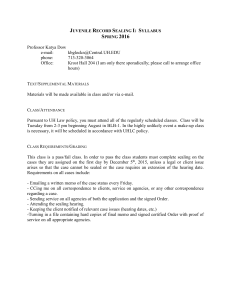
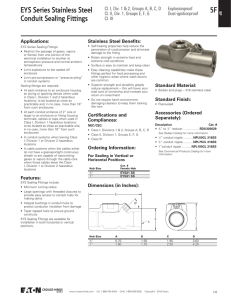

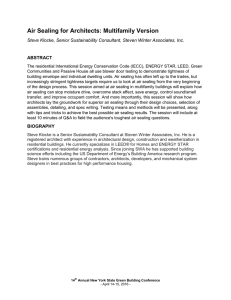
![Wrapping Machine [VP] OPP film wrapping for flat](http://s2.studylib.net/store/data/005550216_1-6280112292e4337f148ac93f5e8746a4-300x300.png)
